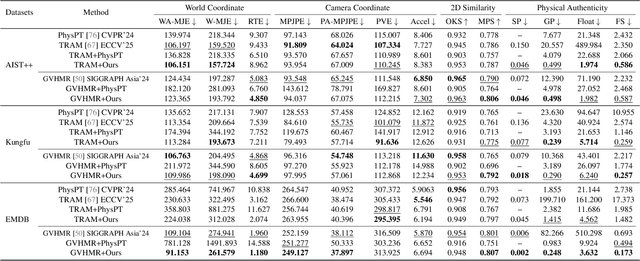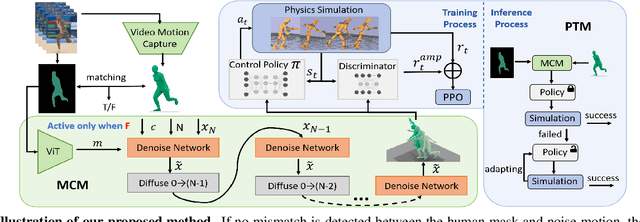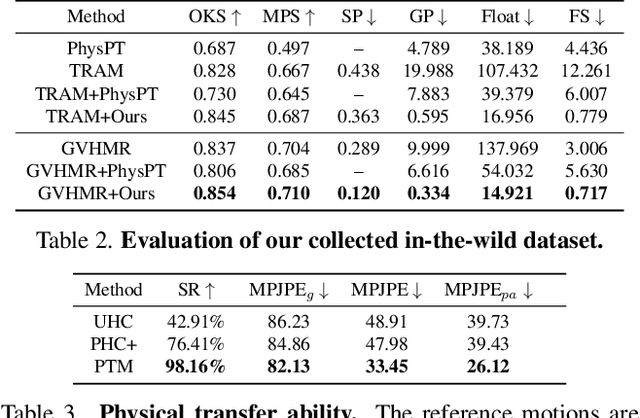Yebin Liu
GeoSAM2: Unleashing the Power of SAM2 for 3D Part Segmentation
Aug 19, 2025Abstract:Modern 3D generation methods can rapidly create shapes from sparse or single views, but their outputs often lack geometric detail due to computational constraints. We present DetailGen3D, a generative approach specifically designed to enhance these generated 3D shapes. Our key insight is to model the coarse-to-fine transformation directly through data-dependent flows in latent space, avoiding the computational overhead of large-scale 3D generative models. We introduce a token matching strategy that ensures accurate spatial correspondence during refinement, enabling local detail synthesis while preserving global structure. By carefully designing our training data to match the characteristics of synthesized coarse shapes, our method can effectively enhance shapes produced by various 3D generation and reconstruction approaches, from single-view to sparse multi-view inputs. Extensive experiments demonstrate that DetailGen3D achieves high-fidelity geometric detail synthesis while maintaining efficiency in training.
AniMer+: Unified Pose and Shape Estimation Across Mammalia and Aves via Family-Aware Transformer
Aug 01, 2025Abstract:In the era of foundation models, achieving a unified understanding of different dynamic objects through a single network has the potential to empower stronger spatial intelligence. Moreover, accurate estimation of animal pose and shape across diverse species is essential for quantitative analysis in biological research. However, this topic remains underexplored due to the limited network capacity of previous methods and the scarcity of comprehensive multi-species datasets. To address these limitations, we introduce AniMer+, an extended version of our scalable AniMer framework. In this paper, we focus on a unified approach for reconstructing mammals (mammalia) and birds (aves). A key innovation of AniMer+ is its high-capacity, family-aware Vision Transformer (ViT) incorporating a Mixture-of-Experts (MoE) design. Its architecture partitions network layers into taxa-specific components (for mammalia and aves) and taxa-shared components, enabling efficient learning of both distinct and common anatomical features within a single model. To overcome the critical shortage of 3D training data, especially for birds, we introduce a diffusion-based conditional image generation pipeline. This pipeline produces two large-scale synthetic datasets: CtrlAni3D for quadrupeds and CtrlAVES3D for birds. To note, CtrlAVES3D is the first large-scale, 3D-annotated dataset for birds, which is crucial for resolving single-view depth ambiguities. Trained on an aggregated collection of 41.3k mammalian and 12.4k avian images (combining real and synthetic data), our method demonstrates superior performance over existing approaches across a wide range of benchmarks, including the challenging out-of-domain Animal Kingdom dataset. Ablation studies confirm the effectiveness of both our novel network architecture and the generated synthetic datasets in enhancing real-world application performance.
GAF: Gaussian Action Field as a Dvnamic World Model for Robotic Mlanipulation
Jun 17, 2025Abstract:Accurate action inference is critical for vision-based robotic manipulation. Existing approaches typically follow either a Vision-to-Action (V-A) paradigm, predicting actions directly from visual inputs, or a Vision-to-3D-to-Action (V-3D-A) paradigm, leveraging intermediate 3D representations. However, these methods often struggle with action inaccuracies due to the complexity and dynamic nature of manipulation scenes. In this paper, we propose a V-4D-A framework that enables direct action reasoning from motion-aware 4D representations via a Gaussian Action Field (GAF). GAF extends 3D Gaussian Splatting (3DGS) by incorporating learnable motion attributes, allowing simultaneous modeling of dynamic scenes and manipulation actions. To learn time-varying scene geometry and action-aware robot motion, GAF supports three key query types: reconstruction of the current scene, prediction of future frames, and estimation of initial action via robot motion. Furthermore, the high-quality current and future frames generated by GAF facilitate manipulation action refinement through a GAF-guided diffusion model. Extensive experiments demonstrate significant improvements, with GAF achieving +11.5385 dB PSNR and -0.5574 LPIPS improvements in reconstruction quality, while boosting the average success rate in robotic manipulation tasks by 10.33% over state-of-the-art methods. Project page: http://chaiying1.github.io/GAF.github.io/project_page/
SemanticSplat: Feed-Forward 3D Scene Understanding with Language-Aware Gaussian Fields
Jun 11, 2025Abstract:Holistic 3D scene understanding, which jointly models geometry, appearance, and semantics, is crucial for applications like augmented reality and robotic interaction. Existing feed-forward 3D scene understanding methods (e.g., LSM) are limited to extracting language-based semantics from scenes, failing to achieve holistic scene comprehension. Additionally, they suffer from low-quality geometry reconstruction and noisy artifacts. In contrast, per-scene optimization methods rely on dense input views, which reduces practicality and increases complexity during deployment. In this paper, we propose SemanticSplat, a feed-forward semantic-aware 3D reconstruction method, which unifies 3D Gaussians with latent semantic attributes for joint geometry-appearance-semantics modeling. To predict the semantic anisotropic Gaussians, SemanticSplat fuses diverse feature fields (e.g., LSeg, SAM) with a cost volume representation that stores cross-view feature similarities, enhancing coherent and accurate scene comprehension. Leveraging a two-stage distillation framework, SemanticSplat reconstructs a holistic multi-modal semantic feature field from sparse-view images. Experiments demonstrate the effectiveness of our method for 3D scene understanding tasks like promptable and open-vocabulary segmentation. Video results are available at https://semanticsplat.github.io.
Parametric Gaussian Human Model: Generalizable Prior for Efficient and Realistic Human Avatar Modeling
Jun 07, 2025Abstract:Photorealistic and animatable human avatars are a key enabler for virtual/augmented reality, telepresence, and digital entertainment. While recent advances in 3D Gaussian Splatting (3DGS) have greatly improved rendering quality and efficiency, existing methods still face fundamental challenges, including time-consuming per-subject optimization and poor generalization under sparse monocular inputs. In this work, we present the Parametric Gaussian Human Model (PGHM), a generalizable and efficient framework that integrates human priors into 3DGS for fast and high-fidelity avatar reconstruction from monocular videos. PGHM introduces two core components: (1) a UV-aligned latent identity map that compactly encodes subject-specific geometry and appearance into a learnable feature tensor; and (2) a disentangled Multi-Head U-Net that predicts Gaussian attributes by decomposing static, pose-dependent, and view-dependent components via conditioned decoders. This design enables robust rendering quality under challenging poses and viewpoints, while allowing efficient subject adaptation without requiring multi-view capture or long optimization time. Experiments show that PGHM is significantly more efficient than optimization-from-scratch methods, requiring only approximately 20 minutes per subject to produce avatars with comparable visual quality, thereby demonstrating its practical applicability for real-world monocular avatar creation.
Interspatial Attention for Efficient 4D Human Video Generation
May 21, 2025Abstract:Generating photorealistic videos of digital humans in a controllable manner is crucial for a plethora of applications. Existing approaches either build on methods that employ template-based 3D representations or emerging video generation models but suffer from poor quality or limited consistency and identity preservation when generating individual or multiple digital humans. In this paper, we introduce a new interspatial attention (ISA) mechanism as a scalable building block for modern diffusion transformer (DiT)--based video generation models. ISA is a new type of cross attention that uses relative positional encodings tailored for the generation of human videos. Leveraging a custom-developed video variation autoencoder, we train a latent ISA-based diffusion model on a large corpus of video data. Our model achieves state-of-the-art performance for 4D human video synthesis, demonstrating remarkable motion consistency and identity preservation while providing precise control of the camera and body poses. Our code and model are publicly released at https://dsaurus.github.io/isa4d/.
ReCoM: Realistic Co-Speech Motion Generation with Recurrent Embedded Transformer
Mar 27, 2025Abstract:We present ReCoM, an efficient framework for generating high-fidelity and generalizable human body motions synchronized with speech. The core innovation lies in the Recurrent Embedded Transformer (RET), which integrates Dynamic Embedding Regularization (DER) into a Vision Transformer (ViT) core architecture to explicitly model co-speech motion dynamics. This architecture enables joint spatial-temporal dependency modeling, thereby enhancing gesture naturalness and fidelity through coherent motion synthesis. To enhance model robustness, we incorporate the proposed DER strategy, which equips the model with dual capabilities of noise resistance and cross-domain generalization, thereby improving the naturalness and fluency of zero-shot motion generation for unseen speech inputs. To mitigate inherent limitations of autoregressive inference, including error accumulation and limited self-correction, we propose an iterative reconstruction inference (IRI) strategy. IRI refines motion sequences via cyclic pose reconstruction, driven by two key components: (1) classifier-free guidance improves distribution alignment between generated and real gestures without auxiliary supervision, and (2) a temporal smoothing process eliminates abrupt inter-frame transitions while ensuring kinematic continuity. Extensive experiments on benchmark datasets validate ReCoM's effectiveness, achieving state-of-the-art performance across metrics. Notably, it reduces the Fr\'echet Gesture Distance (FGD) from 18.70 to 2.48, demonstrating an 86.7% improvement in motion realism. Our project page is https://yong-xie-xy.github.io/ReCoM/.
A Plug-and-Play Physical Motion Restoration Approach for In-the-Wild High-Difficulty Motions
Dec 23, 2024



Abstract:Extracting physically plausible 3D human motion from videos is a critical task. Although existing simulation-based motion imitation methods can enhance the physical quality of daily motions estimated from monocular video capture, extending this capability to high-difficulty motions remains an open challenge. This can be attributed to some flawed motion clips in video-based motion capture results and the inherent complexity in modeling high-difficulty motions. Therefore, sensing the advantage of segmentation in localizing human body, we introduce a mask-based motion correction module (MCM) that leverages motion context and video mask to repair flawed motions, producing imitation-friendly motions; and propose a physics-based motion transfer module (PTM), which employs a pretrain and adapt approach for motion imitation, improving physical plausibility with the ability to handle in-the-wild and challenging motions. Our approach is designed as a plug-and-play module to physically refine the video motion capture results, including high-difficulty in-the-wild motions. Finally, to validate our approach, we collected a challenging in-the-wild test set to establish a benchmark, and our method has demonstrated effectiveness on both the new benchmark and existing public datasets.https://physicalmotionrestoration.github.io
InterDance:Reactive 3D Dance Generation with Realistic Duet Interactions
Dec 22, 2024



Abstract:Humans perform a variety of interactive motions, among which duet dance is one of the most challenging interactions. However, in terms of human motion generative models, existing works are still unable to generate high-quality interactive motions, especially in the field of duet dance. On the one hand, it is due to the lack of large-scale high-quality datasets. On the other hand, it arises from the incomplete representation of interactive motion and the lack of fine-grained optimization of interactions. To address these challenges, we propose, InterDance, a large-scale duet dance dataset that significantly enhances motion quality, data scale, and the variety of dance genres. Built upon this dataset, we propose a new motion representation that can accurately and comprehensively describe interactive motion. We further introduce a diffusion-based framework with an interaction refinement guidance strategy to optimize the realism of interactions progressively. Extensive experiments demonstrate the effectiveness of our dataset and algorithm.
ManiVideo: Generating Hand-Object Manipulation Video with Dexterous and Generalizable Grasping
Dec 18, 2024



Abstract:In this paper, we introduce ManiVideo, a novel method for generating consistent and temporally coherent bimanual hand-object manipulation videos from given motion sequences of hands and objects. The core idea of ManiVideo is the construction of a multi-layer occlusion (MLO) representation that learns 3D occlusion relationships from occlusion-free normal maps and occlusion confidence maps. By embedding the MLO structure into the UNet in two forms, the model enhances the 3D consistency of dexterous hand-object manipulation. To further achieve the generalizable grasping of objects, we integrate Objaverse, a large-scale 3D object dataset, to address the scarcity of video data, thereby facilitating the learning of extensive object consistency. Additionally, we propose an innovative training strategy that effectively integrates multiple datasets, supporting downstream tasks such as human-centric hand-object manipulation video generation. Through extensive experiments, we demonstrate that our approach not only achieves video generation with plausible hand-object interaction and generalizable objects, but also outperforms existing SOTA methods.
 Add to Chrome
Add to Chrome Add to Firefox
Add to Firefox Add to Edge
Add to Edge